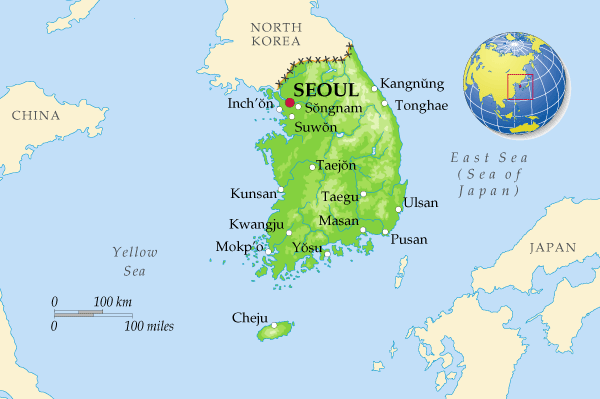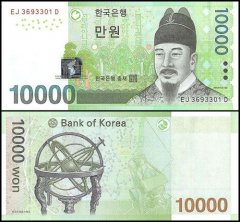Population : 48 324 000 habitants (est. 2002)
Pays voisins : Corée du Nord
Densité : 488.16 hab./km²
Superficie : 98 992 km²
Capitale : Seoul
Principales villes : Pusan, Taegu, Inch'on, Kwangju, Taejon, Ulsan, Masan, Sunwon, Chonju
Point culminant : Halla-san 1 950 m.
Langue(s) parlée(s) : Coréen
Langue(s) officielle(s) : Coréen
Monnaie : Won
Fête nationale : 15 août

Pays voisins : Corée du Nord
Densité : 488.16 hab./km²
Superficie : 98 992 km²
Capitale : Seoul
Principales villes : Pusan, Taegu, Inch'on, Kwangju, Taejon, Ulsan, Masan, Sunwon, Chonju
Point culminant : Halla-san 1 950 m.
Langue(s) parlée(s) : Coréen
Langue(s) officielle(s) : Coréen
Monnaie : Won
Fête nationale : 15 août

Korea ( or ; Hanguk or Joseon – see etymology) is an East Asian territory that is divided into two separate sovereign states, North Korea and South Korea. Located on the Korean Peninsula, Korea is bordered by China to the northwest and Russia to the northeast. It is separated from Japan to the east by the Korea Strait and the Sea of Japan (East Sea), and it is separated from Taiwan to the south by the East China Sea.
The adoption of the Chinese writing system ("Hanja" in Korean) in the 2nd century BC, and Buddhism in the 4th century AD, had profound effects on the Three Kingdoms of Korea which was first united during the Silla Dynasty (57 BC – 935) under the king Munmu of Silla. The united Silla dynasty fell to Goryeo Dynasty in 935 at the end of Later Three Kingdoms of Korea era. Goryeo was a highly cultured state and created the Jikji in the 14th century. The Mongol invasions in the 13th century, however, greatly weakened the nation which was forced to become a tributary state. After the Mongol Empire's collapse, severe political strife followed and Goryeo was replaced by the Joseon Dynasty in 1388.
The first 200 years of Joseon were marked by relative peace and saw the creation of the Korean alphabet Hangul by King Sejong the Great in the 14th century and the rise in influence of Confucianism in the country. During the latter part of the dynasty, however, Korea's isolationist policy earned it the Western nickname the "Hermit kingdom". By the late 19th century, the country became the object of the colonial designs of Japan. In 1910, Korea was annexed by Japan and remained a colony until the end of World War II in August 1945.
In 1945, the Soviet Union and the United States agreed on the surrender of Japanese forces in Korea and Soviet troops occupied north of the 38th parallel, while US troops took surrender south of it. This decision by allied armies soon became the basis for the division of Korea by the two superpowers, exacerbated by their inability to agree on the terms of Korean independence. The two Cold War rivals then established governments sympathetic to their own ideologies, leading to Korea's division into two political entities: North Korea and South Korea.
North Korea, officially the Democratic People's Republic of Korea, is a single-party state with a centrally planned industrial economy. South Korea, officially the Republic of Korea, is a multi-party state with a capitalist market economy, with membership in the Organisation for Economic Co-operation and Development (OECD) and the Group of Twenty.






